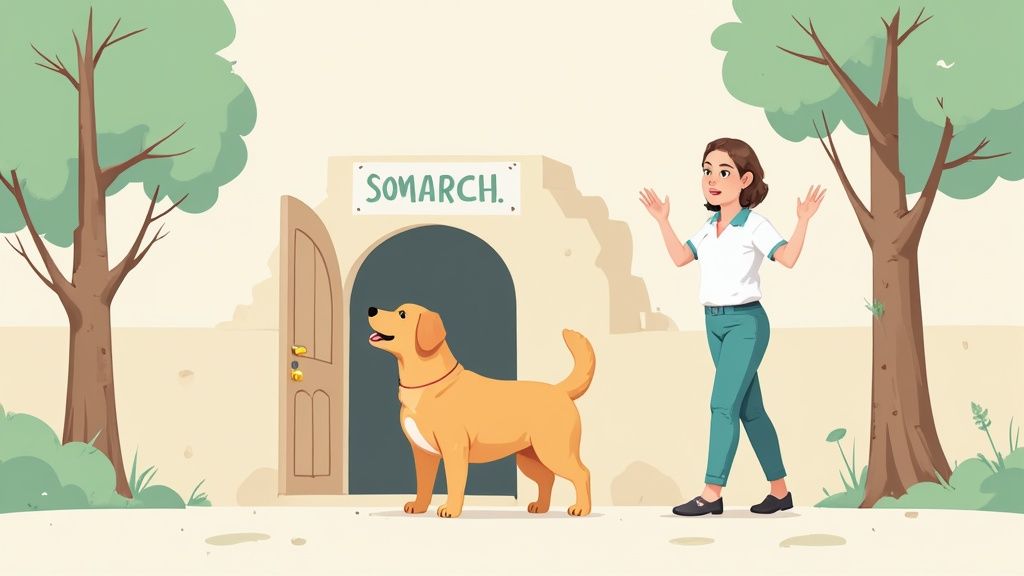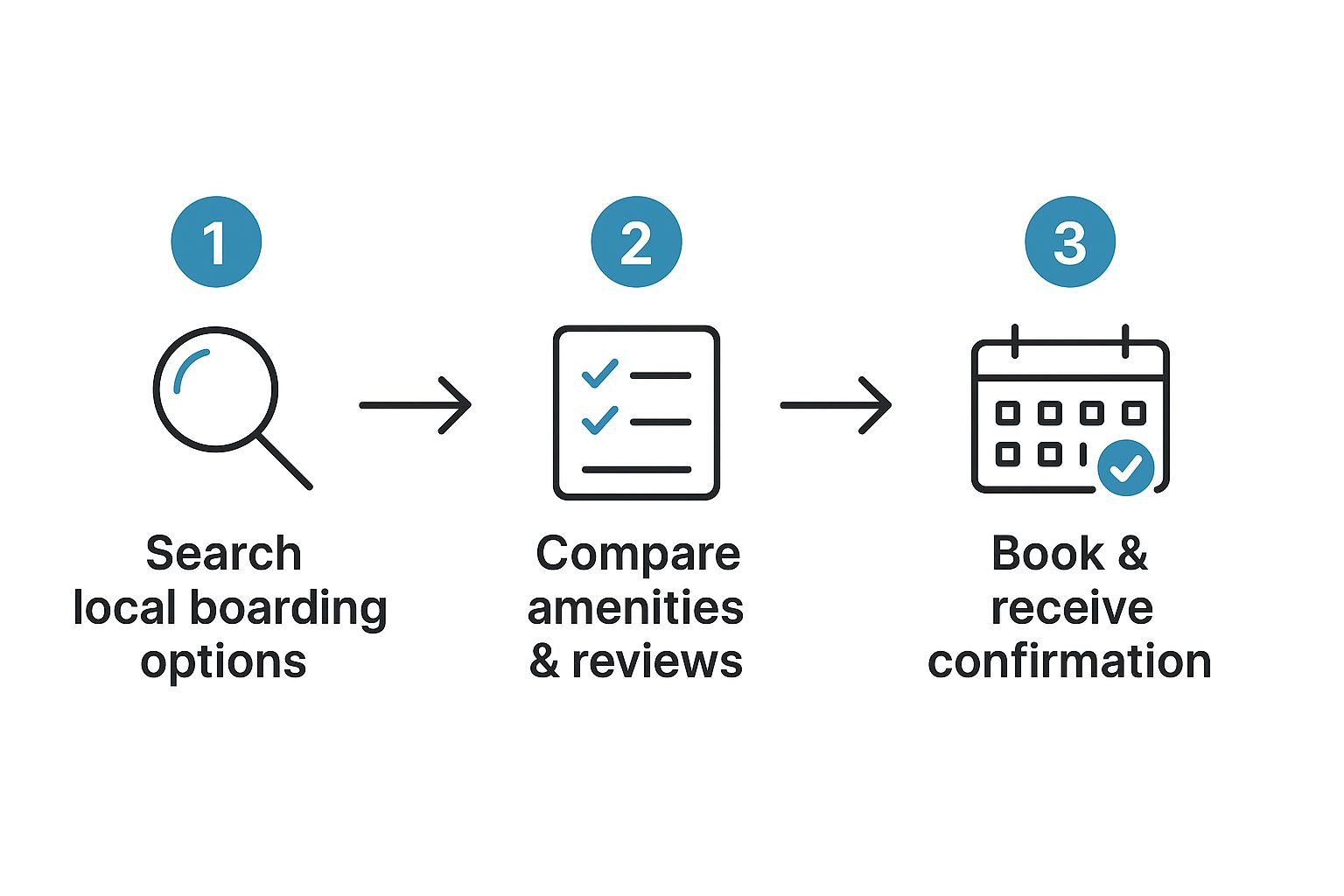Dog Boarding Near Me: A Pet Pro's Guide to Finding a Pawsitively Perfect Stay
- ericavdippold
- Oct 4
- 14 min read
You've booked the flights, the hotel is set, and the excitement for your trip is building. Then, it hits you—that familiar wave of worry. "What about the dog?" As someone who runs a dog boarding facility, I see this every single day, and believe me, I get it. Finding the right dog boarding near me isn't just about finding a space; it's about finding a true home away from home for a member of your family.
Why Choosing the Right Dog Boarding Matters

Let’s be honest, that quick Google search for "dog boarding near me" can be totally overwhelming. You get a list of names and pins on a map, but it doesn't tell you what really matters. It doesn't tell you which staff members will remember your dog’s favorite scratch spot or which place designs playgroups where your shy pup will feel safe enough to blossom.
The truth is, leaving your dog with someone is a massive act of trust. You’re not just booking a kennel; you're entrusting a furry family member to our care. This decision directly impacts your peace of mind while you're away and, more importantly, your dog’s emotional and physical well-being. A great boarding experience can feel like a fun vacation for your dog. A bad one can create anxiety that lasts long after you're back home.
The Shift Toward Quality Pet Care
Today's pet parents rightfully expect more than just a concrete run and a bowl of food, and I'm so glad they do! This shift is part of a much bigger trend in pet care. The global pet boarding services market was valued at approximately USD 8.62 billion in 2024, and it's projected to keep growing. This boom shows a huge movement away from basic kenneling toward facilities like mine that offer enrichment, socialization, and personalized attention.
This guide is my personal playbook, designed to walk you through the exact steps I'd take to find a place for my own dog. We'll cover everything you need to make a choice you can feel good about.
As a dog care professional, my best piece of advice is this: Trust your gut. An in-person tour and your dog's reaction to the environment will tell you more than any website or brochure ever could.
What We Will Cover Together
Forget the stress and confusion. We're going to move beyond a simple online search and get into what truly makes a boarding facility a safe, stimulating, and loving place for your dog. Together, we'll explore:
Spotting the green flags that signal a top-notch facility.
Understanding the critical questions you must ask during a tour.
Preparing your dog for a smooth and happy stay.
Many of the same principles for finding great overnight care also apply when you're looking for daily activities. If you're also exploring daytime options, you’ll find our guide on https://www.pawcation.co/post/how-to-find-the-best-doggy-daycare-near-me incredibly helpful.
Now, let's get started on finding that perfect spot so you can travel with complete peace of mind.
Quick Checklist for Choosing a Boarding Facility
Here’s a quick rundown of the most critical factors to evaluate as you begin your search for local dog boarding.
Key Feature | Why It Matters for Your Dog | Crucial Question to Ask |
|---|---|---|
Cleanliness | Prevents the spread of illness and shows attention to detail. A clean facility is a healthy facility. | "How often are the sleeping and play areas cleaned and disinfected?" |
Staffing Ratio | Ensures enough eyes are on the dogs to prevent conflicts and provide individual attention. | "What is your staff-to-dog ratio, especially during peak playtime?" |
Safety Protocols | Secure fencing, double-gated entries, and emergency plans are non-negotiable for your dog's safety. | "Can you walk me through your procedure if a dog gets sick or injured?" |
Enrichment & Exercise | Prevents boredom and stress. Look for structured play, puzzle toys, or varied activities. | "What does a typical day look like for a boarding dog? How much time is spent outside their kennel?" |
Transparency | Open communication and clear policies build trust. Are they happy to answer all your questions? | "Can I take a full tour of the facility, including where the dogs sleep and play?" |
Think of this table as your starting point—a way to quickly vet potential places before you even schedule a visit.
What to Look for During a Facility Tour

Alright, you've narrowed it down. You’ve found a few local spots with beautiful online galleries and a bunch of glowing reviews. That's a great start, but I’m going to tell you something crucial: a real-life visit tells the true story.
I always insist that potential clients schedule a tour. It's the single best way to get a gut feeling for a place and see if it's right for your dog. This is your chance to play detective and make sure the facility lives up to its shiny website.
When you walk through the door, take a deep breath. Seriously. I call this the "sniff test," and it's incredibly revealing. A well-managed facility shouldn't smell like a "kennel." You shouldn't be hit with an overwhelming wall of urine, feces, or heavy, flowery air fresheners trying to mask a problem. A properly cleaned and ventilated space will smell surprisingly neutral, maybe with just a faint, clean scent of dog.
The Sights and Sounds of a Happy Pack
Next, tune in with your eyes and ears. Watch the dogs that are already there, especially in the play areas. A happy, well-managed pack has a certain energy. You'll hear the pitter-patter of paws and some playful barks, but you shouldn't hear frantic, non-stop barking, whining, or aggressive growling. Those are often red flags for stress or poor supervision.
Look at the dogs themselves. Are their bodies relaxed? Are their tails wagging loosely? Do they seem engaged with each other and the staff, or are some huddled in corners, looking anxious? A top-notch boarding facility will have playgroups that feel balanced and joyful, not chaotic and overwhelming.
A key indicator of a great facility is how the staff interacts with the dogs. Look for genuine affection—are they calling dogs by name, offering gentle pets, and speaking in a kind tone? Or are they just standing around, looking at their phones? The best caregivers are actively engaged and clearly love their jobs.
Inspecting the Physical Environment
Now it's time to get into the nitty-gritty of the facility itself. This isn't about being picky; it's about ensuring your dog's safety and comfort. Don't be shy about asking to see everything—from the play yards to where the dogs sleep. Any reputable business will be proud to show you their entire operation.
Here's a quick checklist of things to keep an eye out for during your tour:
Secure Fencing and Gates: Check that all outdoor fences are tall, sturdy, and have no gaps a dog could squeeze through. Indoor gates, especially those leading to exits, should be secure. I always look for a double-gated system to prevent any would-be escape artists from making a run for it.
Cleanliness of All Areas: Look beyond the sparkling lobby. Are the play floors clean? Are the communal water bowls filled with fresh water? Ask to peek into the individual sleeping areas—are the kennels or suites sanitary with clean, comfortable bedding?
Ventilation and Temperature: The building should feel comfortable, not stuffy, overly hot, or too cold. Good air circulation is vital for health and for keeping odors under control.
Hazard-Free Zones: Scan the play areas for anything a curious dog could chew on or ingest, like exposed electrical wires, cleaning supplies left out, or small, broken pieces of toys. The entire space needs to be thoroughly dog-proofed.
Taking the time for a thorough tour is the most important step you can take. It provides the peace of mind that comes from seeing with your own eyes that your best friend will be safe, happy, and well-cared-for while you're away.
Critical Questions to Ask Any Boarding Facility
You've done the tour, you've got a feel for the place, and now it's time to dig deeper. Think of this as an interview—you're hiring someone for the most important job in the world: taking care of your best friend. Knowing what to ask is the key to cutting through the marketing fluff and understanding what a facility is really all about.
Finding the right spot often boils down to a pretty simple journey: you start by searching for "dog boarding near me," you compare your top options, and then you book with confidence.

We're right in that crucial middle stage now, where asking the right questions makes all the difference.
Staffing and Safety Protocols
Let's be honest, the most beautiful facility in the world is useless without a great team. The people looking after your dog are everything. Their experience, training, and attentiveness are the foundation of your dog's safety and happiness.
For me, a low staff-to-dog ratio is non-negotiable. It's the only way to ensure every dog gets the supervision they need.
Here are the questions I always lead with:
What is your staff-to-dog ratio in the playgroups? In my business, we aim for at least one staff member for every 10-15 dogs. Anything higher than that, and I start to worry about how closely they're really watching things.
What kind of training does your staff receive? The best places invest in continuous education on dog body language, managing group dynamics, and pet first aid. We make sure our team is always learning.
How are playgroups separated? The answer should be about more than just size. Grouping by temperament is just as critical. You don't want your shy, gentle giant mixed in with a bunch of hyper, small terriers.
The global market for dog services is set to rocket past USD 20.10 billion in 2025, largely because owners like us are demanding smarter, more behavior-focused care. This trend, reported by Fortune Business Insights, proves just how vital it is to grill facilities on their staff training and socialization methods. It's the new standard for quality care.
Emergency and Health Procedures
Nobody likes thinking about worst-case scenarios, but you absolutely have to know the facility has a plan. A vague or hesitant answer here is a massive red flag. Their emergency protocols should be clear, rehearsed, and inspire confidence.
You also need to be crystal clear on their health policies:
What is your procedure if a dog becomes ill or is injured? A good facility will have a go-to local vet and a clear plan for getting a dog there quickly if needed.
How do you handle disagreements between dogs? Look for answers that focus on de-escalation and positive reinforcement. Any mention of punitive methods is an immediate deal-breaker for me.
What are your vaccination requirements? Don't be put off by strict rules—they’re a great sign! It means the facility is serious about protecting all the dogs in their care. You can see how their rules stack up by reading our guide to doggy daycare vaccination policies.
Daily Routines and Enrichment
Finally, get a picture of what your dog’s day will actually look like. Will they be bored in a kennel all day, or will they be engaged, exercised, and mentally stimulated? Ask the staff to walk you through a typical day, from morning potty break to tuck-in time.
How much time do dogs actually spend outside of their kennels?
What kinds of activities or enrichment do you provide beyond just group play?
Can I bring my dog’s own food and comfort items, like their favorite bed or a familiar-smelling blanket?
Getting solid, confident answers to these questions is what will allow you to leave for your trip feeling relaxed, knowing your dog is in the best possible hands.
Comparing Different Types of Dog Boarding

When you start searching for dog boarding, you'll find the options are way more diverse than you might think. The old-school image of a "kennel" with concrete runs and chain-link doors just doesn't capture the full picture anymore. As someone who's been in this business for years, I think it's fantastic that pet parents have so many choices today.
Getting a handle on the different models is your first real step. It's not just about finding a safe place—it’s about finding the right place for your dog’s specific personality and needs.
Traditional Kennel-Style Boarding
This is what most people picture first. In a traditional setup, each dog gets their own private space—a kennel or a suite—for sleeping, eating, and chilling out. During the day, they'll either join supervised group play sessions or get one-on-one time with staff for walks and fetch.
This classic style can be a perfect fit for a few types of dogs:
Dogs who need their own space: Some pups just get overwhelmed by constant social interaction. Having a quiet spot to retreat and recharge can make all the difference.
Dogs with special dietary needs: With private spaces, staff can easily manage specific diets without the risk of another dog grabbing their food.
Pups still mastering their social skills: It offers a structured way to socialize in a controlled environment, which is less intimidating than being in a group 24/7.
Cage-Free and Pack-Style Boarding
On the flip side, you have cage-free boarding. Think of it as a giant, supervised slumber party for your dog. In these facilities, the dogs spend nearly all their time together in a group, from playtime to bedtime.
This setup is a dream for high-energy, confident, and super-social dogs who live for the pack experience. It’s not for everyone, though. Older dogs, shy pups, or more independent types can find it incredibly stressful without a private area to decompress.
A non-negotiable for cage-free boarding is a rigorous screening process. Any reputable facility will have a strict temperament test to make sure every single dog is a good fit for the group. Safety has to be the top priority, period.
In-Home Boarding and Luxury Pet Hotels
For a more personal touch, in-home boarding is a wonderful option. Your dog stays right in a caregiver's home, which can be the least stressful choice for anxious dogs or those who crave constant human companionship. It's the closest thing to being at their own home.
Then you have the rise of luxury "pet hotels." These places are becoming more common as we increasingly treat our pets like family—a trend that's helping drive the pet boarding market toward a projected USD 35.4 billion by 2032. These high-end facilities offer everything from private suites with webcams and TVs to spa treatments and curated activity packages. If you're curious about the price tag on these premium options, you can see how much dog boarding really costs in our detailed breakdown.
Ultimately, the best choice comes down to one thing: knowing your dog. Are they a social butterfly or a quiet homebody? Answering that question is the key to finding their perfect home away from home.
Getting Your Dog Ready for Their Big Stay
The vacation is booked, the bags are almost packed, and now it's time to get your best friend ready for their own little getaway. As someone who's welcomed countless dogs for their first stay, I can tell you that a little bit of prep work on your end makes a huge difference. It’s what transforms a nervous drop-off into a happy, tail-wagging start to their staycation.
The All-Important Trial Run
The absolute best thing you can do to set your dog up for success is to schedule a trial visit before the real trip. This doesn't have to be a huge commitment—a half-day of daycare or a single overnight stay is perfect.
Think of it from your dog's perspective. This short visit lets them sniff out the new environment, meet the staff, and hear all the new sounds without the pressure of a long stay. Most importantly, it teaches them that this is a safe, fun place and that you always come back. That positive association is priceless.
What to Pack (and What to Leave at Home)
When packing your dog's bag, the "less is more" approach is usually best. A good boarding facility will have plenty of comfortable bedding, bowls, and safe toys. Your job is to bring the essentials that provide comfort and consistency.
Here’s my go-to packing list for owners:
Their Own Food: The last thing you want is an upset stomach ruining their stay. Pack each of your dog's meals in a separate, clearly labeled bag. This keeps them on their regular diet and helps prevent digestive issues.
Necessary Medications: Bring any medications in their original prescription bottles. Make sure the dosage instructions are crystal clear for the staff.
Something That Smells Like You: This is my favorite pro tip. An old t-shirt you've worn (don't wash it!) or a small blanket from the couch can be a powerful comfort item.
That familiar scent of home is incredibly reassuring for a dog in a new place. It's like leaving a little piece of yourself with them, which can significantly ease any anxiety, especially at nighttime.
You can leave their giant orthopedic bed, favorite squeaky toys, and food bowls at home. In a bustling group environment, personal items can easily get misplaced or damaged. The facility will have everything needed to keep them cozy and entertained.
The Calm and Confident Goodbye
Okay, this is often the toughest part for us humans, but it’s critical. Your dog is a master at reading your energy. If you're stressed, worried, or sad when you leave, they'll immediately think something is wrong.
I've seen it play out hundreds of times: a calm owner creates a calm dog. When it's time for the hand-off, keep it short, sweet, and upbeat. A quick scratch behind the ears, a cheerful "Be a good boy, I'll see you soon!" and a confident smile as you hand the leash to the staff is all it takes.
It's just like dropping a kid off at daycare. A long, drawn-out, emotional farewell only heightens their anxiety. By staying positive, you're sending a powerful signal that they are in a safe, fun place and that you'll be back soon. A happy goodbye is the first step to a happy stay for everyone involved.
Your Top Dog Boarding Questions, Answered
As a dog boarding provider myself, I’ve heard it all. After countless conversations with dog parents, I've noticed a few questions pop up time and time again. It’s completely natural to have a checklist of concerns when you're trusting someone with your best friend.
So, let's dive into the most common questions I hear when people are searching for "dog boarding near me." These answers come straight from my real-world experience running a daycare and boarding business.
How Much Should I Expect to Pay?
This is usually the first thing people ask, and for good reason! The truth is, the cost varies quite a bit depending on your location and the type of facility you're looking at.
On average, you're probably looking at a range of $30 to $60 per night for a good, standard boarding kennel.
Of course, you can find options on either side of that. The super-luxe "pet resorts" with private suites, webcams, and gourmet meals can easily push $75 to over $100 per night. My best advice is to get a complete pricing sheet upfront. Always ask what's included and what's extra—things like medication administration or special play sessions can sometimes be add-on fees.
What Vaccinations Are Truly Necessary?
Any boarding facility worth its salt will have strict vaccination requirements. Don't see this as a hassle; see it as a massive green flag. It shows they're committed to keeping every single dog safe and healthy.
At a minimum, you'll need proof of these core vaccinations:
Rabies: This is a legal requirement in most states.
DHPP: A combo vaccine that protects against Distemper, Hepatitis, Parainfluenza, and Parvovirus.
Bordetella: You might know this as "kennel cough." It's an absolute must for any place where dogs are socializing.
Some places, like mine, may also require the Canine Influenza vaccine. The easiest thing to do is get a printout of your dog's records from your vet and make sure everything is up-to-date well before their stay.
A great facility will listen intently and work with you to tailor a plan for your dog. If they brush off your specific questions or concerns, that’s your cue to find another provider who sees your dog as the individual they are.
How Do You Handle Anxious Dogs?
This one is so important because every dog’s personality is unique. You have to be totally transparent with the staff about your dog’s quirks, fears, and anxieties.
If your dog gets nervous around new people or has separation anxiety, ask them directly how they approach that. Do they have quieter areas for dogs who need some space? Will they provide extra one-on-one attention? For dogs with medical or dietary needs, you need to feel 100% confident that they can follow your instructions to the letter. A fantastic boarding partner will want every little detail to make your dog’s stay as seamless and happy as possible.
Finding that perfect home-away-from-home is all about feeling a sense of trust and comfort. If you happen to be in the King of Prussia area and are looking for a caring, attentive place for your pup, we at Pawcation would be thrilled to meet you both.
You can learn more about our in-home doggy daycare and boarding services at https://pawcation.co.
Comments